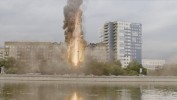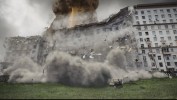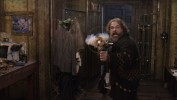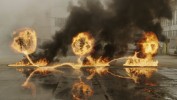THE DARKEST HOUR
DIRECTOR : Chris Gorak
PRODUCTION : Regency Enterprises
VFX SUPERVISOR : Pierre Buffin

MAKING OF : Jerome Pesnel
MUSIC : Texas Rangers - Zombie Zombie
NUMBER OF SHOTS : 153
Production notes
The Darkest Hour is a 3D thriller about a group of American teens who find themselves stranded in Moscow after the planet is attacked by aliens. This is the directorial debut of Chris Gorak, best known for his art direction on films like “Minority Report” and “Fight Club”. This is the first 3D movie shot in Russia, it is also co-produced by Russian film director Timur Bekmambetov (9, Wanted).
In The Darkest Hour, Gorak’s innovative approach is to create an invisible alien made of lethal energy, a new type of enemy never seen before in alien movies.
BUF was approached by New Regency to make artistic proposals and was assigned the development of 153 shots. The whole project lasted for nearly 10 months under the artistic direction of Pierre Buffin with constant communication with the director Chris Gorak and the VFX supervisor Stefen Fangmeier, award winning designer on “Jurassic Park”.
BUF was asked to propose ideas based on the story-line and generate three major elements: the alien, the alien towers and the tram scene.
The Alien
The challenge was to depict a believable alien without a physical body. BUF went through an open-ended research process, freestyle, generating several hundred proposals by 10 designers. The drawings of Stéphane Levallois especially attracted the producer’s attention. Several animation tests were made to bring the alien to life, crafting his movement and attitude. The Alien was meant to be footless, have a tendril and a shield making him transparent, the transparency being an alien tool; so the question of coherence was crucial. The producers didn’t want an easily recognizable alien, for example something looking like a dragon or a fish. During the exchange of proposals and decisions, improving the alien on each iteration, BUF defined the final look for the alien and its tendril.
After the conception phase, it took more than 4 months of R&D to develop the graphic tools used for the 3D rendering. BUF used its proprietary software to manage and control the shots for the energy shield, a veil composed of millions of complex mathematical curve. This is where BUF excels, developing custom tools for crafting unique special effects.
The film is shot and post produced in stereo, so 3D glasses are mandatory. The use of 3D is particularly justified in this film as the alien can only be perceived in 3D form, it is almost invisible otherwise. BUF used its B-Mac laboratory to realize specific adjustments for 3D effects.
The story is told from the characters’ perspective. One of the aliens’ features is electrical devices turn themselves on in their presence. The viewer can’t really guess when there will be danger, as the alien’s presence is only detected when there is a light source switched off, which turns itself on when the creature passes nearby. For characters this means it’s safer to walk at night, which is an interesting storytelling device since daylight becomes scarier than night-time, inverting conventions.
The Alien Towers
The aliens come to earth to suck up energy and metallic elements; this is why their dens look like organic drills. The BUF team went through a long research and development process. The initial idea was a tower structure from which materials would drift away but eventually evolved into the idea of energy columns. Not all CG shot ideas were used in the end as some demanded a costly, time-consuming process but this was part of the creative process; ideas evolved until the concept was finally agreed on, and the production pipeline followed afterwards.
The Tram scene
The shooting was difficult because of weather and other problems such as the fires blazing through Russia at the time. For example, the shooting of a scene featuring the two main characters and the alien on a tram became badly compromised due to the smoke, so the supervisor came up with the idea of shooting the scene in a studio with a green background. This hitch prompted BUF to change the location of the scene and create a new setting in full CG.
With The Darkest Hour, BUF demonstrated once again that it is one of the rare French companies with a world class reputation, alongside with the best VFX companies in California and the UK, and also as a visual creative force in cinema.





































